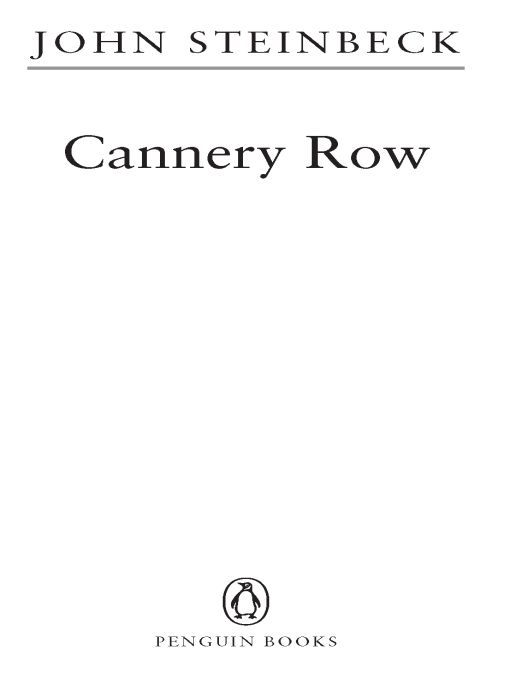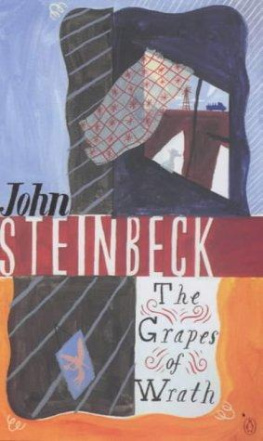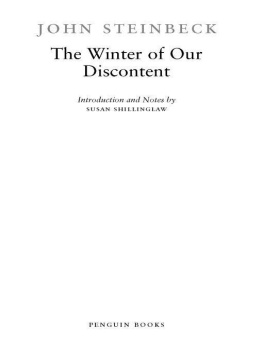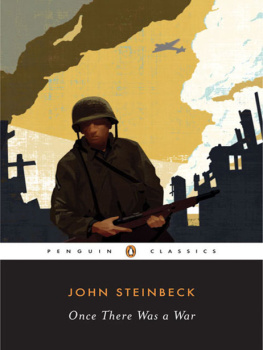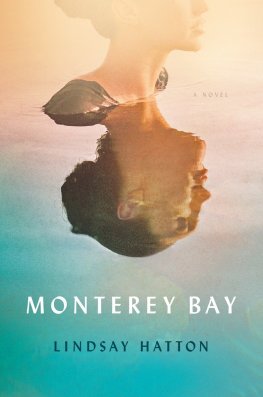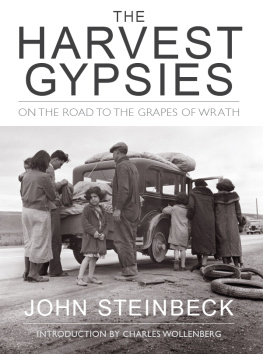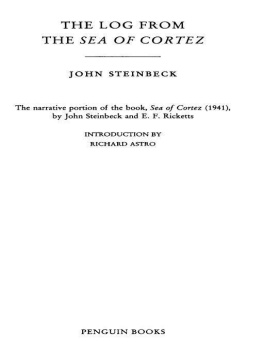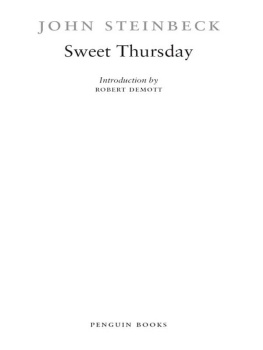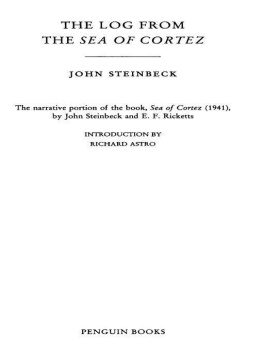Table of Contents
PENGUIN BOOKS
CANNERY ROW
Born in Salinas, California, in 1902, JOHN STEINBECK grew up in a fertile agricultural valley about twenty-five miles from the Pacific Coastand both valley and coast would serve as settings for some of his best fiction. In 1919 he went to Stanford University, where he intermittently enrolled in literature and writing courses until he left in 1925 without taking a degree. During the next five years he supported himself as a laborer and journalist in New York City and then as a caretaker for a Lake Ta-hoe estate, all the time working on his first novel, Cup of Gold (1929). After marriage and a move to Pacific Grove, he published two California fictions, The Pastures of Heaven (1932) and To a God Unknown (1933), and worked on short stories later collected in The Long Valley (1938). Popular success and financial security came only with Tortilla Flat (1935), stories about Montereys paisanos. A ceaseless experimenter throughout his career, Steinbeck changed courses regularly. Three powerful novels of the late 1930s focused on the California laboring class: In Dubious Battle (1936), Of Mice and Men (1937), and the book considered by many his finest, The Grapes of Wrath (1939). Early in the 1940s, Steinbeck became a filmmaker with The Forgotten Village (1941) and a serious student of marine biology with Sea of Cortez. He devoted his services to the war, writing Bombs Away (1942) and the controversial play-novelette The Moon Is Down (1942). Cannery Row (1945), The Wayward Bus (1947), The Pearl (1947), A Russian Journal (1948), another experimental drama, Burning Bright (1950), and The Log from the Sea of Cortez (1951) preceded publication of the monumental East of Eden (1952), an ambitious saga of the Salinas Valley and his own familys history. The last decades of his life were spent in New York City and Sag Harbor with his third wife, with whom he traveled widely. Later books include Sweet Thursday (1954), The Short Reign of Pippin IV: A Fabrication (1957), Once There Was a War (1958), The Winter of Our Discontent (1961), Travels with Charley in Search of America (1962), America and Americans (1966), and the posthumously published Journal of a Novel: The East of Eden Letters (1969), Viva Zapata! (1975), The Acts of King Arthur and His Noble Knights (1976), and Working Days: The Journals of The Grapes of Wrath (1989). He died in 1968, having won a Nobel Prize in 1962.
BY JOHN STEINBECK
FICTION
Cup of Gold
The Pastures of Heaven
To a God Unknown
Tortilla Flat
In Dubious Battle
Saint Katy the Virgin
Of Mice and Men
The Red Pony
The Long Valley
The Grapes of Wrath
The Moon Is Down
Cannery Row
The Wayward Bus
The Pearl
Burning Bright
East of Eden
Sweet Thursday
The Winter of Our Discontent
The Short Reign of Pippin IV
NONFICTION
Sea of Cortez: A Leisurely Journal of Travel and Research
(in collaboration with Edward F. Ricketts)
Bombs Away: The Story of a Bomber Team
A Russian Journal (with pictures by Robert Capa)
The Log from the Sea of Cortez
Once There Was a War
Travels with Charley in Search of America
America and Americans
Journal of a Novel: The East of Eden Letters
PLAYS
Of Mice and Men
The Moon Is Down
COLLECTIONS
The Portable Steinbeck
The Short Novels of John Steinbeck
Steinbeck: A Life in Letters
OTHER WORKS
The Forgotten Village (documentary)
Viva Zapata! (screenplay)
CRITICAL LIBRARY EDITION
The Grapes of Wrath (edited by Peter Lisca)
For
ED RICKETTS
who knows why or should
Cannery Row in Monterey in California is a poem, a stink, a grating noise, a quality of light, a tone, a habit, a nostalgia, a dream. Cannery Row is the gathered and scattered, tin and iron and rust and splintered wood, chipped pavement and weedy lots and junk heaps, sardine canneries of corrugated iron, honky tonks, restaurants and whore houses, and little crowded groceries, and laboratories and flophouses. Its inhabitants are, as the man once said, whores, pimps, gamblers, and sons of bitches, by which he meant Everybody. Had the man looked through another peephole he might have said, Saints and angels and martyrs and holy men, and he would have meant the same thing.
In the morning when the sardine fleet has made a catch, the purse-seiners waddle heavily into the bay blowing their whistles. The deep-laden boats pull in against the coast where the canneries dip their tails into the bay. The figure is advisedly chosen, for if the canneries dipped their mouths into the bay the canned sardines which emerge from the other end would be metaphorically, at least, even more horrifying. Then cannery whistles scream and all over the town men and women scramble into their clothes and come running down to the Row to go to work. Then shining cars bring the upper classes down: superintendents, accountants, owners who disappear into offices. Then from the town pour Wops and Chinamen and Polaks, men and women in trousers and rubber coats and oilcloth aprons. They come running to clean and cut and pack and cook and can the fish. The whole street rumbles and groans and screams and rattles while the silver rivers of fish pour in out of the boats and the boats rise higher and higher in the water until they are empty. The canneries rumble and rattle and squeak until the last fish is cleaned and cut and cooked and canned and then the whistles scream again and the dripping, smelly, tired Wops and Chinamen and Polaks, men and women, straggle out and droop their ways up the hill into the town and Cannery Row becomes itself againquiet and magical. Its normal life returns. The bums who retired in disgust under the black cypress tree come out to sit on the rusty pipes in the vacant lot. The girls from Doras emerge for a bit of sun if there is any. Doc strolls from the Western Biological Laboratory and crosses the street to Lee Chongs grocery for two quarts of beer. Henri the painter noses like an Airedale through the junk in the grass-grown lot for some part or piece of wood or metal he needs for the boat he is building. Then the darkness edges in and the street light comes on in front of Doras the lamp which makes perpetual moonlight in Cannery Row. Callers arrive at Western Biological to see Doc, and he crosses the street to Lee Chongs for five quarts of beer.
How can the poem and the stink and the grating noisethe quality of light, the tone, the habit and the dreambe set down alive? When you collect marine animals there are certain flat worms so delicate that they are almost impossible to capture whole, for they break and tatter under the touch. You must let them ooze and crawl of their own will onto a knife blade and then lift them gently into your bottle of sea water. And perhaps that might be the way to write this bookto open the page and to let the stories crawl in by themselves.
Lee Chongs grocery, while not a model of neatness, was a miracle of supply. It was small and crowded but within its single room a man could find everything he needed or wanted to live and to be happy clothes, food, both fresh and canned, liquor, tobacco, fishing equipment, machinery, boats, cordage, caps, pork chops. You could buy at Lee Chongs a pair of slippers, a silk kimono, a quarter pint of whiskey and a cigar. You could work out combinations to fit almost any mood. The one commodity Lee Chong did not keep could be had across the lot at Doras.

